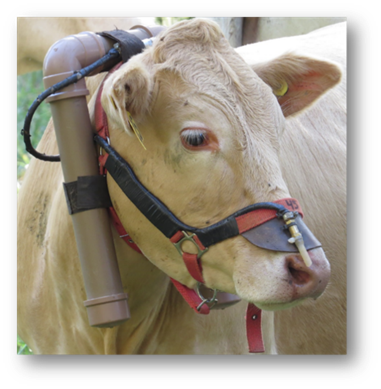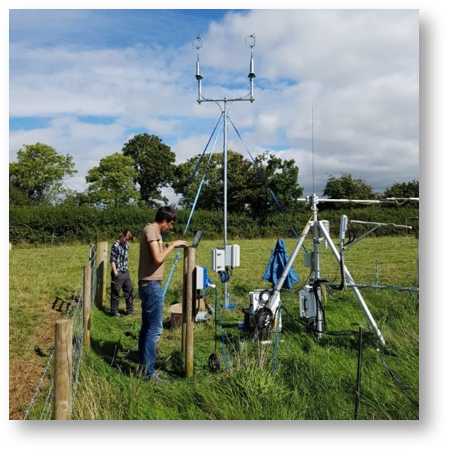North Wyke and the Farm Platform as a Test-Bed For Advances in Sensor Technologies
In addition to the IoT network of water flow and water quality sensors installed throughout the Farm Platform, we are testing a variety of sensor and sensor communication technologies. Some that provide data at a local data collection level and those that can be fully integrated using various communication approaches such as Low Power, Wide Area (LPWA) networking using the LoRaWAN protocol or Narrow Band. Some examples of current sensor deployments are given below, and
For further details or enquiries on using North Wyke and the Farm Platform to test sensors, please contact Paul Harris (paul.harris@rothamsted.ac.uk) or Jane Hawkins (jane.hawkins@rothamsted.ac.uk).
Current Studies
Air Quality
Methane emissions
Enteric methane (CH4) emissions from freely-grazing animals are measured using a harmless tracer gas technique. The well-established method relies on a known source of the synthetic inert tracer, sulphur hexafluoride (SF6), that is inserted into the rumen as a bolus. The SF6 tracer technique works on the basis that excretions of two gases sourced from the rumen disperse identically into the animal’s environment, and thus have identical probability of interception by a simple ‘breath’ sampler located near the nasal cavity and fitted to a halter. The samples of breath are analysed in the laboratory. This technique is enabling the unknown release rate of CH4 to be estimated.

Water Harvesting
SmartPond
SDS Water Infrastructure Systems are interested in using smart technology to control the release and retention of water principally with an interest to alleviate flooding. They use models and weather forecasts to predict future rain events, prior to them occurring, and their technology is designed to release stored water, thereby creating increased water storage capacity. This storage can then be utilised to retain water during the high fall event to reduce risks of downstream or sewer flooding.
Currently and as part of another ERDF Impact Lab project, SDS are using shed roof rainwater sited at the Farm Platform livestock buildings as a test bed for their new IoT-based technology. Rainwater falling on the Rowden and Whiddon Down livestock buildings flows into harvesting tanks, and release of the water is remotely controlled in order to optimise water use (say, through efficient use of water for field spraying).
Further work is planned, where SDS will use the roof rainwater lagoon at Rowden Buildings as a test bed for their new technology. Currently rainwater falling on the Rowden buildings currently flows into one small lagoon, from the lagoon its release is controlled using a traditional ‘non-smart’ hydro brake vortex flow control. SDS would like to replace the hydro brake with their own technology which will allow them to vary the speed water is released or retained within the lagoon.
Animal Health, Welfare and Behaviour
Cattle
Behaviour and activity
Cattle movement and activity using GPS and pedometers are used to further our understanding of a range of aspects of pasture-based beef production systems including behaviour, welfare, performance, and emissions. With these devices we can map where the animals have been grazing and overlay this information on a range of different measured variables such as pasture quality, livestock performance, dung and urine deposits, and gaseous emissions such as methane. Data form the animals can be automatically collected whilst they are in the field or in housing. For example, we are monitoring step count, standing time, lying time, standing bouts and lying bouts using a mobile, trailer mounted CowAlert system provided by IceRobotics Ltd to capture and download data from leg-mounted IceQube pedometers in-situ from grazing dairy x beef cattle to examine the impact of differing grazing management on animal behaviour and activity.
Water usage
Using LoRaWAN enabled water meters, we can measure and compare water usage in a rotational cell grazing system uses very small, mobile drinking troughs with a conventional set-stocked/continuous grazing system which uses typical large, static water troughs. Photo would be nice
Drinking behaviour, health and welfare
Understanding changes in rumen temperature using a temperature bolus enables us to understand how life events may influence cattle health, welfare and productivity. Commonly used within the dairy industry, the temperature bolus is administered orally and stays in the rumen throughout the life of the animal. As an example of this methodology, we are using LoRaWAN enabled temperature sensors to monitor the temperature of drinking water in differing grazing management systems in combination with rumen temperature boluses to investigate whether grazing management/drinking trough design effects drinking behaviour of cattle.
Remote sensing
Current capacity and call for collaborations
Currently, North Wyke has limited remote sensing capability but is eager to enhance this part of its research. Aims are to capture remotely sensed data from a range of scales from the platform’s forage harvester (a CIEL funded project - https://www.cielivestock.co.uk/) to drones (we currently have two devices with licence holders and links to the GrassCheckGB project - www.grasscheckgb.co.uk ) to satellite platforms in order to monitor biomass dynamics according field grass/crop cover type and also field livestock type.
This can be combined with drone-based SfM photogrammetry and airborne LiDAR for sward characterisation and the system’s Carbon assessment. Drone sensing approaches exploiting fine-grained thermal imaging systems can be used to map fam platform sub-catchment hydrology and alongside targeted fine-grained multispectral drone surveys can be used to map urine patches that drive greenhouse gas emissions such as N2O. All such data can in turn, inform nutrient content, quality and loss, and livestock performance.
Previous Studies
Air Quality
Low Cost Eddy Covariance System
This study is in collaboration with Rob Clement (University of Edinburgh), and Dr Hill (Exeter University) who designed a prototype of a low-cost system which promises to reduce the cost of Eddy Covariance (EC) by an order of magnitude, making wide-spread use of this instrumentation economically feasible. The prototype has undergone some testing at field sites in Morecambe Bay and Dumfries and Galloway. The second-generation system now requires testing, and the technique needs be proven at a wider range of field sites.
We are evaluating a new pump-based version of this developmental EC system alongside our conventional EC system as well as the first-generation fan-based version of the system. The overall aim of the study will be to provide long-term (i.e. annual) greenhouse gas datasets for comparison of the systems to corroborate the relative performance of the inexpensive systems and quantify their accuracy.
Two additional masts are installed at the Farm Platform site and are in the wind shadow of the existing (high cost) EC system (to avoid any turbulent disturbance to the existing system).

Mast 1: This system uses a Gill Wind Master Pro anemometer. On this mast we will mount three infrared gas analysers (IRGAs):
1. The original expensive EC system, using a ‘fan’- based system
2. The second-generation inexpensive EC system, using a pump-based system.
3. A LI-COR LI7500 for corroboration. Data are recorded by a Campbell Scientific Cr3000.
Mast 2: This system uses a Gill Wind Master (not Pro) anemometer and a pump based inexpensive EC system. The data for this system are recorded with an inexpensive Arduino data logger.
Water Quality
Artificial Intelligence-enabled low-cost sensors
The aim of this ERDF Impact Lab funded project (https://www.impactlab.org.uk/) is to develop a network of AI-enabled water and soil sensors across the Farm Platform. British Telecom (BT) have enabled a Narrow-Band IoT Radio Network across its Mobile Network cell(s) which cover the Farm Platform. This facilitates communication with the installed sensor network. BT have also developed an IoT data processing facility to land, process, transform, store and publish the data on the its web platform. The aim of the project is to develop an understanding of the use of low power radio, low cost sensors and AI to deliver high frequency insights for on-farm use.
Initially, water conductivity sensors will be installed in the flow cells within the flume cabins on each of the 5 blue treatment catchments. The sensors are battery powered and will utilise the NB-IoT radio module which will link the sensor data to the BT IoT Platform. The sensors will be co-located with the current water quality instrumentation including YSI conductivity sensors. The project will compare the current (high cost) and new sensor (low cost) data output.
The conductivity sensors will be used to develop AI-enabled water quality monitoring. One of the hypotheses of this project is that through using AI, it is possible to determine a variety of chemical & biological parameters through modelling only a small subset of sensor measurements. Here a conductivity sensor will be used to derive 20 new physical/biological properties. Some measurements can be validated through comparison with sensor data from the current Farm Platform instrumentation, others not. The second stage of the project will install AI-enabled soil sensors across the Farm Platform.
Spectrolyser
We are testing the hypothesis that the in-situ high-resolution technique (first tested in a laboratory set-up in Luxembourg, LIST) is suitable for obtaining high-frequency measurements of sediment properties at the flume outlet under natural runoff conditions. The main application to test in this research is the Spectro::lyser sensor. This sensor emits a light beam through an open path, through which water and sediment flows. The sensor measure absorbance (as influenced by the water and sediment). In this research, the absorbance values measured will be related to the sediment (properties) in the water transported through the flume outlet.
Results of the absorbance measurements will be validated by two different methods. The first method includes taking soil samples, sieving them, and creating water and sediment solutions under lab conditions (with different concentrations of sediments added) to test the absorbance signal under controlled conditions. In this way, absorbance of the same sediments can be compared (under natural conditions/influence, and under completely controlled conditions in the lab [only sediments and blank water]).
The second validation method of the in-field absorbance spectra uses the sediments captured by the automatic water sampler. Results from the Spectro::lyser (installed at the field outlet) are related to those times samples are taken by the automatic water sampler. The sediment from this automatic sampler will be analysed (e.g. for colour properties, chemical properties) to validate the absorbance readings of the Spectro::lyser at the corresponding times. In both methods, the goal is to see to what extent absorbance measurements in situ (influenced by natural conditions) relate to the mobilised sediment and its properties.
